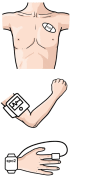Comparison of consistency between wireless and conventional wired monitoring systems in gastrointestinal endoscopy
- PMID: 40754611
- PMCID: PMC12319100
- DOI: 10.1038/s41598-025-12927-2
Comparison of consistency between wireless and conventional wired monitoring systems in gastrointestinal endoscopy
Abstract
There is a lack of research on use and effectiveness of wearable monitoring devices in the setting of invasive procedures, such as gastrointestinal endoscopy. Our study aimed to compare the consistency between wireless and conventional wired monitoring systems in gastrointestinal endoscopy under sedation. One hundred and twenty patients undergoing gastrointestinal endoscopy with sedation/anesthesia were fitted with both wireless and conventional wired monitoring systems. Multiple physiological parameters, including heart rate (HR), pulse rate, peripheral oxygen saturation (SpO2) and systolic (SBP), diastolic (DBP) and mean blood pressure (MAP), were monitored and recorded simultaneously. The correlation coefficients were 0.999, 0.939, 0.606, 0.837, 0.934 and 0.941 for HR, pulse rate, SpO2, SBP, DBP and MAP, respectively (all p < 0.001). The HR exceeded its limits of agreements (LoAs) and clinically acceptable consistency thresholds in 56 (4.17%) and 41 (3.05%) data, pulse rate in 84 (6.0%) and 137 (9.80%) data, SpO2 in 116 (8.30%) and 18 (1.28%) data, SBP in 39 (6.32%) and 121 (19.61%)data, DBP in 34 (5.34%) and 52 (8.43%) data, and MAP in 28 (4.54%) and 57 (9.24%) data. The polar concordance rate at 30 degrees was 59.31% for SBP, 61.12% for DBP, and 68.55% for MAP according to polar plot trending analysis. This study demonstrated that the wireless monitoring system showed adequate agreement with wired system for HR and SpO₂, but suboptimal agreement for pulse rate, SBP, DBP, and MAP during gastrointestinal endoscopy. The blood pressure measurements meets the ISO 81060-2 accuracy criteria. Overall, wireless monitoring is generally acceptable for gastrointestinal endoscopy, but further validation is needed for high-risk patients.
Keywords: Bland-Altman plot; Consistency; Gastrointestinal endoscopy; Wired monitoring; Wireless monitoring.
© 2025. The Author(s).
Conflict of interest statement
Declarations. Competing interests: The authors declare no competing interests.
Figures




Similar articles
-
Cardiovascular Effects of Stimulant and Non-Stimulant Medication for Children and Adolescents with ADHD: A Systematic Review and Meta-Analysis of Trials of Methylphenidate, Amphetamines and Atomoxetine.CNS Drugs. 2017 Mar;31(3):199-215. doi: 10.1007/s40263-017-0410-7. CNS Drugs. 2017. PMID: 28236285 Free PMC article.
-
Evaluating the Validity and Utility of Wearable Technology for Continuously Monitoring Patients in a Hospital Setting: Systematic Review.JMIR Mhealth Uhealth. 2021 Aug 18;9(8):e17411. doi: 10.2196/17411. JMIR Mhealth Uhealth. 2021. PMID: 34406121 Free PMC article.
-
Variation within and between digital pathology and light microscopy for the diagnosis of histopathology slides: blinded crossover comparison study.Health Technol Assess. 2025 Jul;29(30):1-75. doi: 10.3310/SPLK4325. Health Technol Assess. 2025. PMID: 40654002 Free PMC article.
-
Multiple-frequency bioimpedance devices for fluid management in people with chronic kidney disease receiving dialysis: a systematic review and economic evaluation.Health Technol Assess. 2018 Jan;22(1):1-138. doi: 10.3310/hta22010. Health Technol Assess. 2018. PMID: 29298736 Free PMC article.
-
Electronic cigarettes for smoking cessation.Cochrane Database Syst Rev. 2022 Nov 17;11(11):CD010216. doi: 10.1002/14651858.CD010216.pub7. Cochrane Database Syst Rev. 2022. Update in: Cochrane Database Syst Rev. 2024 Jan 8;1:CD010216. doi: 10.1002/14651858.CD010216.pub8. PMID: 36384212 Free PMC article. Updated.
References
Publication types
MeSH terms
Grants and funding
LinkOut - more resources
Full Text Sources

